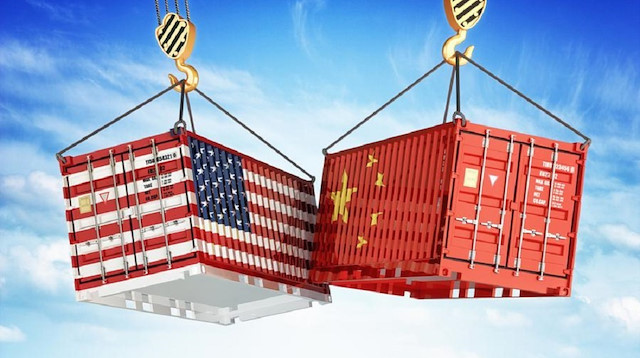
Decades of American business, trade that made today's China might fall apart if Trump re-elected next year
By Vakkas Dogantekin
- The writer is acting main chief correspondent for the Americas desk at Anadolu Agency's English service.
ANKARA (AA) - World's biggest two economies, the U.S. and China have been mired in a trade and tariff war ignited by U.S. President Donald Trump who accuses the Asian country of stealing intellectual property from American companies and growing exponentially at the expense of American national interests.
Trump and his former advisors -- including Steve Bannon, a former senior ally who is seen as a major factor in the president's 2016 election win -- designated China as the country's main rival since the outset of campaigning for office. They have accused American corporations of contributing to deindustrialization trends in the U.S by transferring production facilities to China for decades, boosting the East Asian giant's economy.
The tariff war between the locomotives of international trade, now in its 17th month, has sent shockwaves through global markets.
- Brain cramp of Trump
Trump administration mistakenly assumed that the U.S. is way more advantageous, taking a quick victory against China for granted.
Trump in his "great and unmatched wisdom" thought that trade wars are easy to win and China would not retaliate at a time when the American market is the most lucrative and the biggest. To his astonishment, not only China but also others, even traditional allies, have retaliated against the U.S.
Trump also assumed that U.S. tariffs on China would pave the way for American companies to relocate their supply chains back to the U.S., which also didn't happen. Most companies protested Trump in favor of China or moved their manufacturing to other affordable South Asian countries.
Last but not the least, the U.S. president in May said the country's "great Patriot Farmers will be one of the biggest beneficiaries" of his trade policies against China. Yet, the farmers were devastated and farm bankruptcies in September surged 24% amid a turbulent year of trade war and bad weather, reaching an 8-year-high, according to data from American Farm Bureau Federation -- the nation's largest general farm organization.
When the realities of the trade war hit U.S. farmers in Republican states ahead of critical 2020 elections, Trump and his aides looked for ways to delay, pause or cancel further sanctions against Chinese buyers who kept American farms in business.
Additionally, the administration had to provide $28 billion in federal aid to farmers to prevent traditionally red farm states from feeling blue ahead of the presidential election in November.
- Bull in China shop
After months of negotiations between trade delegations, U.S. and China have agreed in principle to "phase one" of a long-sought trade pact that would bring an end to their punishing bilateral trade war.
The current agreement -- not yet finalized on paper -- covers intellectual property, financial services, and China's commitment to purchase up to $50 billion worth of U.S. farm products.
US trade representative Robert Lighthizer earlier in December said phase one trade deal is expected to be signed "in the first week of January," yet, the Chinese officials have not confirmed any signing date or any meeting between the countries' leaders, according to South China Morning Post.
Chinese state media so far only confirmed that an interim deal had been agreed on December 13 with the U.S. in principle, two days before a deadline for additional U.S. tariffs, but added that the text needs further study.
It is no wonder that the Chinese side is trying to maximize its gains by taking advantage of the Democrat-led impeachment process against the U.S. president, whose hand is weaker in global foreign policy negotiations under domestic pressure.
- Timeline of US-China trade war
In early July 2018, the U.S. imposes 25% duties on around $34 billion of imports from China, which retaliates with a 25% tariff on 545 goods originating from the U.S. worth $34 billion.
Washington escalates the tension with additional 25% tariffs on another $16 billion of Chinese goods the following month.
China immediately hits back with 25% tariffs on $16 billion of U.S. goods.
In late September 2018, the U.S. places 10% taxes on $200 billion of Chinese imports, and China responds by placing customs duties on $60 billion of U.S. goods.
On Dec. 1, 2018, Trump and Jinping agree to hold fires at the G20 summit in Argentina, mutually suspending a planned tariff due to come into effect on Jan. 1, 2019.
Easing the tension further in mid-December 2018, China suspends tariffs on U.S. cars and auto parts for three months from Jan. 1, and resumes its purchase of soybeans, giving a sigh of relief to American farmers.
But trade negotiations break down early May 2019 and the U.S. raises tariffs on $200 billion worth of Chinese goods from 10% to 25%, to which China again loses no time to respond with raised tariffs on $60 billion worth of goods from June 1.
In mid-May 2019, the U.S. Department of Commerce announces that Chinese telecom giant Huawei is added to its "entity list", which effectively banned the U.S. companies from doing business with the company without approval. In response, China announces that it will come up with a list of its own and raised tariffs on $60 billion worth of products.
In late June, the two presidents decide to bury the hatchet once again at the G20 summit in Japan, with the U.S. delaying major new tariffs and easing restrictions placed on Huawei.
On and off negotiations come to a standstill early August, when Trump announces plans to place a 10% tariff on $300 billion of worth of Chinese goods from Sept. 1 and designated China as a "currency manipulator" on Aug. 5.
A little over a week later, Trump changes his mind and announces that the planned tax on many of the $300 billion of Chinese products have either been delayed or removed and taxes of 10% on $155 billion of products including phones, laptop computers and video game consoles will be delayed until Dec. 15.
Late August, China announces tariffs of 5-10% on $75 billion of U.S. goods for the period of Sept. 1-Dec. 15, and also says it will reinstate tariffs on the U.S. cars and car parts starting from Dec. 15.
In September, the U.S. tariffs on more than $125 billion worth of Chinese products begin as expected.
After China announces that it will ease tariffs on certain U.S. products, Trump responds positively and agrees to delay new tariffs on $250 billion worth of Chinese goods on Oct.1-15 as a good will gesture to mark the 70th anniversary of the People’s Republic of China.
Early September, China said it will keep U.S. soybeans, pork, and other farm goods out of additional trade war tariffs.
Following negotiations in early October, U.S. says it will delay a planned tariff raise of 25-30% on $250 billion of Chinese goods due Oct. 15.
On Dec. 13, China and the U.S. finally agree to a phase one trade deal days before a 15% tariff was set to be placed on nearly $160 billion of Chinese goods.
Trump administration also agrees to reduce tariffs on $120 billion of Chinese goods levied in September.
Returning the favor, China also suspends tariffs on U.S. goods due to come into force on Dec. 15.
Trump announced on Tuesday, the last day of 2019, he "will be signing our very large and comprehensive Phase One Trade Deal with China on January 15."
"The ceremony will take place at the White House. High level representatives of China will be present. At a later date I will be going to Beijing where talks will begin on Phase Two!" he added on Twitter.
Almost 18 months of one step further-two steps back trade negotiations, the economic bilateral relations have eased for the time being, but given the impulsiveness and embedded China aversion of Trump, things might spiral out of control if he is re-elected in November.
* Opinions expressed in this article are the author’s own and do not necessarily reflect the editorial policy of Anadolu Agency.
Hello, the comments you share on our site are a valuable resource for other users. Please respect other users and different opinions. Do not use rude, offensive, derogatory, or discriminatory language.
The floor is all yours.








